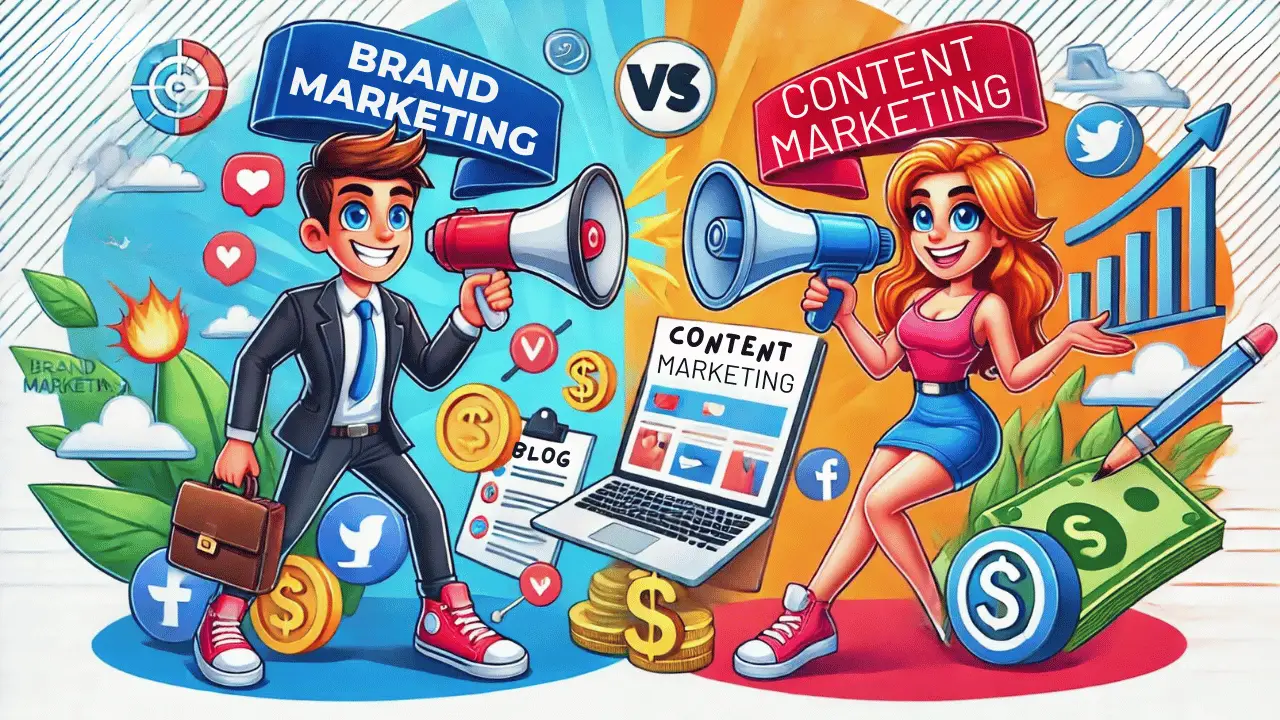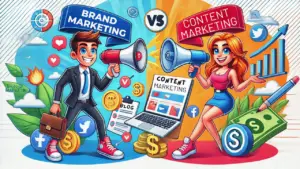Brand Marketing vs Content Marketing: What’s Better for Affiliate Marketers?
When you’re diving into the world of affiliate marketing, you’ll inevitably hit a fork in the road: brand marketing vs content marketing. Both are buzzwords thrown around in digital marketing circles, but what’s the real difference?
More importantly, which approach is going to make your affiliate marketing efforts skyrocket? Let’s cut through the jargon and get straight to what you need to know.
What’s the Difference Between Brand Marketing and Content Marketing?
At first glance, these two strategies might seem like they’re from the same family—and they are. But they serve very different purposes in the marketing ecosystem.
Brand Marketing is all about creating an identity. Think of it as the DNA of a business. It focuses on how the audience perceives a brand, whether that’s through a logo, messaging, values, or reputation. When done right, brand marketing creates trust, recognition, and emotional connection. Think Apple, Nike, or even smaller, niche brands—these names resonate because their brand marketing game is strong.
Content Marketing, on the other hand, is the workhorse. It’s the strategy of using valuable content—blog posts, videos, social media updates, you name it—to engage, educate, and eventually convert your audience. Content marketing focuses more on delivering information and solutions to your audience’s pain points. When you hear “content is king,” this is exactly what they’re talking about.
Which One Should Affiliate Marketers Focus On?
Here’s the deal: both brand marketing and content marketing are important, but they serve different roles depending on where you are in your affiliate marketing journey. Let’s break it down.
Brand Marketing: Establishing Trust and Recognition
If you’re in it for the long haul and want to create a recognizable identity in your niche, brand marketing can’t be ignored. This is especially true if you’re building a blog, YouTube channel, or social media presence as an affiliate marketer.
Why? Because people buy from those they know, like, and trust. If your audience constantly sees your consistent messaging, catchy logo, and engaging tone of voice across different platforms, you become more than just another affiliate—they start seeing you as an authority.
For instance, let’s say you’re in the health and wellness niche. By focusing on brand marketing, you’re not just recommending supplements; you’re becoming the “go-to” resource for all things wellness-related. Your brand isn’t just about the products—it’s about the values you stand for, the style you represent, and the trust you build.
Content Marketing: The Engine Driving Conversions
Now let’s talk content marketing. For most affiliate marketers, this is where the magic happens. You can have the flashiest brand in the world, but without content that attracts and converts, you’re not going anywhere. Content marketing is about getting your message in front of the right people at the right time.
When you’re promoting affiliate products, content marketing gives you a platform to:
- Educate your audience through detailed reviews and comparisons.
- Solve problems with how-to guides and tutorials.
- Drive traffic through SEO-optimized blog posts, videos, and social media content.
For affiliate marketers, content marketing is non-negotiable. You’re essentially guiding your audience through the buyer’s journey—warming them up with valuable content and then subtly introducing them to the products you’re promoting. This is where the money is made.
The Ideal Strategy: Combining Brand Marketing and Content Marketing

Here’s the thing: you don’t have to pick one over the other. In fact, the most successful affiliate marketers seamlessly blend brand marketing and content marketing.
Start with Content: If you’re just getting started, content marketing should be your primary focus. Crank out high-quality content that helps your audience and builds trust. Use SEO strategies to get your content in front of the right eyes and optimize it for conversions.
Build Your Brand as You Go: Once you start gaining traction, begin focusing more on brand marketing. Develop a consistent look, tone, and message. Your content will continue driving traffic and conversions, but your brand marketing will ensure people remember you, come back to you, and ultimately become loyal followers.
Why Content Marketing is the First Step for Affiliate Success
If you’re just dipping your toes into affiliate marketing, it’s tempting to get caught up in branding from the get-go. But let’s be real: no one cares about your brand until you’ve given them a reason to care. That’s where content marketing comes in.
Think of content marketing as the foundation of your affiliate business. It’s where you build trust, establish authority, and—most importantly—drive traffic. Without content, you’re just another voice in a crowded room. With it, you become the solution to your audience’s problems. And once you’ve built that trust, monetization becomes a whole lot easier.
Here’s a breakdown of how content marketing lays the groundwork for your affiliate strategy:
SEO is Your Best Friend
When you’re starting out, paid ads might be out of reach. But SEO? That’s where content marketing shines. By targeting long-tail keywords specific to your niche, you can attract organic traffic without spending a dime.
For instance, if you’re in the tech niche, writing a post like “Best Budget Laptops for Students 2024” can bring in readers who are ready to buy. Sprinkle in your affiliate links, and you’ve got yourself a winning strategy. But remember: the key is offering value. If your content is just a glorified sales pitch, people will bounce faster than you can say “conversion rate.”
Building a Content Strategy that Converts
Creating content isn’t just about pumping out articles or videos—it’s about crafting a journey. Your audience is on a path, from discovering your content to finally making a purchase. Here’s how you can guide them:
- Top-of-Funnel Content (Awareness Stage): At this stage, your audience is just getting to know you. Focus on educational content like how-tos, listicles, and beginner’s guides. This is where you reel them in by solving their problems.
- Middle-of-Funnel Content (Consideration Stage): Now that they trust you, it’s time to dig deeper. Create product comparisons, in-depth reviews, and solution-focused content that addresses their specific needs. This is where you subtly introduce affiliate offers as solutions.
- Bottom-of-Funnel Content (Decision Stage): Here’s where the conversions happen. Case studies, testimonials, and direct recommendations work best here. By now, your audience is primed to buy—they just need that final nudge.
Scaling Your Content Marketing Efforts
Once you’ve mastered the basics, it’s time to scale. This is where content marketing and brand marketing start to merge. Your brand begins to take shape as your content gains traction. You might start to notice that certain pieces of content are consistently bringing in traffic and sales. Double down on what works.
- Repurpose Content Across Platforms: A well-performing blog post can be turned into a YouTube video, an infographic for Pinterest, or a series of posts on Instagram. Repurposing content helps you reach a wider audience without reinventing the wheel.
- Build an Email List: Your content has attracted visitors—now it’s time to keep them engaged. Offering a lead magnet (like a free guide or checklist) in exchange for an email address is a great way to nurture relationships. Once they’re on your list, you can regularly offer valuable content and sprinkle in affiliate promotions.
- Leverage User-Generated Content: Encourage your audience to share their experiences with the products you recommend. Not only does this build trust, but it also strengthens your brand. Feature their reviews, testimonials, and social media posts to create a sense of community.
The Subtle Art of Brand Marketing for Affiliate Marketers

As you continue building your content library, your brand naturally begins to take form. But brand marketing doesn’t have to be this overwhelming, complex task. It’s more about consistency than perfection. Let’s break down how you can easily integrate brand marketing into your content strategy.
Consistency in Voice and Messaging
Your audience should be able to recognize your brand across all platforms. Whether they’re reading your blog, watching your YouTube channel, or scrolling through your social media, the tone, messaging, and values should align. Are you casual and friendly, or more formal and data-driven? Choose a brand voice and stick to it.
Developing a Visual Identity
Even if you’re not a design expert, having a consistent visual identity goes a long way. Choose a color palette, a logo, and fonts that represent your brand. Use them across your website, social media graphics, and email newsletters. Over time, these visual elements become associated with your brand, making you instantly recognizable.
Storytelling that Resonates
One of the most powerful tools in brand marketing is storytelling. Sharing your journey—how you started, the challenges you faced, and the successes you achieved—creates a connection with your audience. People don’t just buy products; they buy into stories. By sharing your experiences and values, you humanize your brand and build deeper trust with your audience.
Brand Marketing vs Content Marketing: It’s Not a Competition
Here’s the truth: focusing solely on brand marketing vs content marketing misses the point. The two should complement each other. Content marketing brings in the audience, educates them, and builds trust. Brand marketing turns that trust into loyalty, ensuring that people keep coming back for more.
As an affiliate marketer, you can’t afford to ignore either. Your content is what attracts and converts, but your brand is what keeps your audience coming back, even when they’re not actively looking to buy. When you strike the right balance, you’ll create a long-term, sustainable business that stands out from the competition.
Key Takeaways for Affiliate Marketers
- Start with Content Marketing: Content is what drives traffic and builds trust. Focus on creating valuable, SEO-optimized content that speaks directly to your target audience’s needs and pain points.
- Build Your Brand as You Grow: As you gain momentum, establish a strong brand identity. Make sure your logo, messaging, and tone are consistent across all channels.
- Blend Both Strategies for Maximum Impact: The real power comes when you combine the trust and recognition of brand marketing with the conversion-driven tactics of content marketing.
- Measure and Optimize: Track how both your brand presence and content are performing. Adjust your strategies based on what’s working—be it through refining your messaging or tweaking your content strategy.
Wrapping Up: A Winning Strategy for Affiliate Marketers
So, what’s the final takeaway? If you’re just starting out, dive headfirst into content marketing. Create valuable, SEO-optimized content that solves your audience’s problems. Once you’ve built a steady stream of traffic and trust, start developing your brand identity. Over time, the combination of powerful content and a recognizable brand will set you apart in the crowded affiliate marketing space.
Remember, the most successful affiliate marketers are those who can blend both brand marketing and content marketing seamlessly. Focus on providing value first, build trust, and watch as your audience grows into loyal customers who not only buy from your recommendations but actively seek them out.













